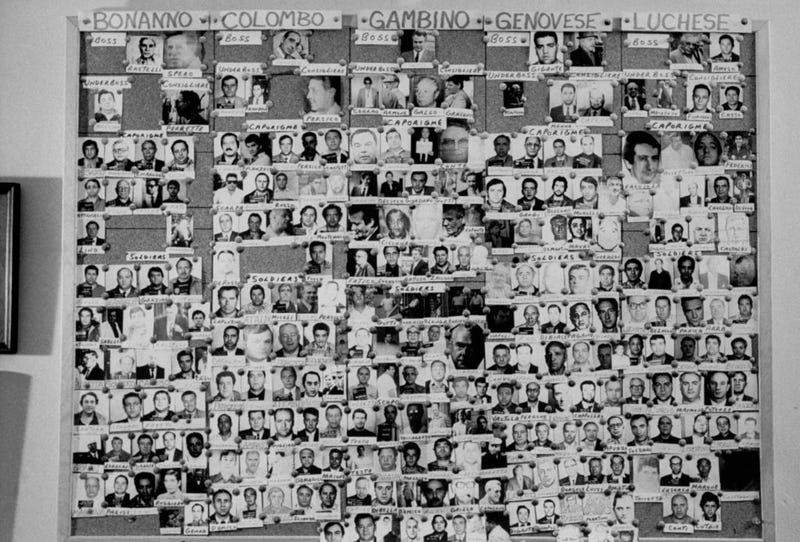
NEW YORK (BLOOMBERG) — For decades, New York’s Mafia acted like rival hedge funds, each guarding its own market share. Now, they’re more like a network of family offices pooling capital, technology, and muscle for shared gain.
That cooperation was on full display in last week’s sweeping indictment by Brooklyn prosecutors outlining a vast sports-gambling ring. Officials described what they called an unprecedented alliance among four of the city’s five Mafia families — the Genovese, Gambino, Bonanno, and Lucchese — working together to rig high-stakes poker games and cheat high-rollers out of millions.
“Bringing four of the five families together in a single indictment is extraordinarily rare,” Police Commissioner Jessica Tisch said at a press conference. “It tells you how much money was on the table.”
The case details how the Mafia that once divided the city by neighborhood now runs on shared profit and shared technology. Modified card shufflers and X-ray tables supplement the knives and pistols of the past, even as the enforcement methods remain familiar.
“They used threats, intimidation, and violence,” Tisch said. “It’s the same pattern we’ve seen for decades.”
According to prosecutors, gamblers lost more than $7 million in the rigged games, including one who dropped nearly $1.9 million.
Each family took a cut. The Bonannos ran a game on Lexington Avenue, the Gambinos another on Washington Place, and the Genovese and Lucchese crews handled collections, prosecutors say. Hidden sensors inside $10,000 DeckMate shuffling machines read every card, transmitting the order to an off-site “driver,” who texted the winning hand to a “quarterback” seated at the table. A touch on the wrist or a brush across a stack of chips signaled who would win.
The scheme was a modern reflection of an old institution. La Cosa Nostra — “our thing” — took root in New York during Prohibition, when Sicilian and southern Italian gangs carved out empires in bootlegging and gambling. From those origins emerged figures who became part of city lore: Charles “Lucky” Luciano, who helped create the modern Mafia; Carlo Gambino, who built his family into the city’s most powerful; and John Gotti, the swaggering boss convicted of murder in 1992.
While cooperation is rare, the gambling case wasn’t the first time the organizations worked together. Beginning in 2012, the Bonanno and Genovese families quietly joined forces in a gambling ring that stretched into Wall Street suburbs across Queens and Long Island. They ran bets through a coffee bar, a shoe-repair shop, and a soccer club — fronts for an operation later detailed in a 2022 indictment that also accused a Nassau County detective of taking cash to warn them before raids.
Other prosecutions have shown the same instinct for adaptation. In 2021, reputed Colombo family leaders were charged with trying to seize control of a labor union and its health fund, threatening to put a union officer “in the ground” if he resisted. Wiretaps captured bosses in their seventies and eighties directing extortion schemes from diners and garages.
“The illegal businesses, in place for many years, require constant attention and protection,” prosecutors wrote in one filing.
The violence didn’t always come from rivals. In 2018, Sylvester “Sally Daz” Zottola, a Bronx landlord and reputed Bonanno associate, was shot dead in his SUV at a McDonald’s drive-through after months of ambushes. Prosecutors said his son orchestrated the killing, enlisting members of an alleged Bloods street gang member to murder his father and brother to seize control of the family’s real estate holdings.
That killing came less than a year after prosecutors charged the Lucchese family’s top hierarchy — including its reputed acting boss, underboss, consigliere, and four captains — with murder, racketeering, and drug trafficking across New York and New Jersey.
Other cases have shown how the Mafia never really disappears, it mutates. In 2016, prosecutors charged Vincent Esposito, son of a reputed Gambino underboss, with running an extortion racket targeting labor unions. That same year, reputed Genovese associate Pasquale “Patsy” Parrello was indicted for illegal gambling and loansharking in the Bronx. Both cases, prosecutors said, underscored “an enterprise that continues to function as a cohesive criminal organization.”
Two years later, a union leader was accused of diverting pension and medical funds into sham investments for kickbacks. Prosecutors said that crime relied on the same “structure of loyalty and concealment” that defined La Cosa Nostra for generations.
“Organized crime is still active and remains a threat both nationally and internationally,” said Robert Boyce, former chief of detectives for the NYPD and a 35-year veteran of the force. The gambling case “is evidence that law enforcement is vigilant and well coordinated, both federally and locally, in combating these criminal enterprises.”
More stories on bloomberg.com.
